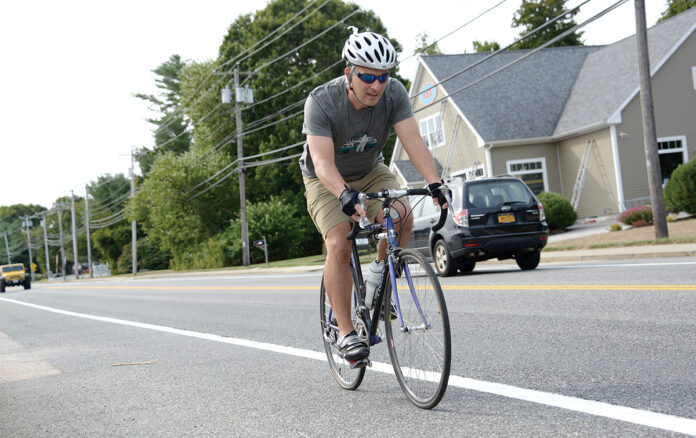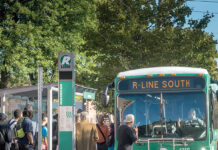More people are riding bicycles during the pandemic, and collisions between cyclists and motor vehicles are also on the rise. In almost half of the cases where the crash happened because a car overtook a bicyclist on the road, drivers reported that they didn’t see the bike, according to a recent national study.
Technology making bicyclists more visible – not through reflective material, but by wearing something that is automatically detected by a vehicle’s built-in collision-warning system – could be a way to help reduce those crashes.
A wearable technology is being developed by Revolution Cycle Works Co., of Charlestown, working with the University of Rhode Island. The company’s idea, begun several years ago, has reached the prototype phase, according to Revolution Cycle Works President Joe Loberti.
Patents have been filed for the technology as well, he said.
The technology is two-fold. One part involves the development of a symbol worn by a cyclist that would be detected by a camera system, and the detection would be improved with machine-learning systems. Such car-based technologies are becoming more common in new vehicles, and, where a driver might not see a bicyclist as the car approaches, the system would detect the wearable tech.
Another part of the technology would incorporate threads or subsurface materials into the symbol that would be detected by radar systems used by new motor vehicles to prevent collisions.
The importance of making advances in bicyclist safety is driven by injury and fatality data, Loberti said.
‘We fully envision joggers, pets even, will have this technology.’
JOE LOBERTI, Revolution Cycle Works Co. president
Almost 900 people were killed in the U.S. in bicycle-vehicle collisions in 2018, the last year for which federal statistics were available. The 857 people killed on bikes that year was nearly a 7% increase from 2017 and was the highest total since 1988, when 901 cyclists were killed, according to the U.S. Department of Transportation.
Between 2007 and 2016, the number of nonfatal bicyclist injuries rose across the U.S. from 44,000 annually to 64,000, according to a recent National Transportation Safety Board report.
The NTSB recommended that bicyclists be protected by infrastructure intended to physically separate them from cars, that technology in vehicles to detect them be advanced and that wearing helmets become universal.
The Rhode Island Bicycle Coalition, a cycling advocacy group, said the best way to protect cyclists is through dedicated bike infrastructure.
Kathleen Gannon, chairwoman of the coalition, said drivers are so distracted by warning systems and other technology in cars that she’s unsure that a collision warning involving cyclists would be effective.
“It doesn’t seem as helpful as separated, protected, bicycle infrastructure,” she said. “The most powerful thing is to separate bicyclists from motor vehicle traffic and to engineer intersections with all the road users in mind.”
For Loberti, the goal of increased safety isn’t just a theoretical solution.
Loberti, a cyclist himself, said he has frequent close calls while riding his bike. His business primarily sells bicycle components, such as brake pads and gearing cables, to bike shops, but more than three years ago he started thinking about technology that would make cyclists more visible to motorists.
The problem with existing, car-based collision-detection systems, he said, is they’re designed to see much larger objects than a bicycle. They have difficulty distinguishing a slender bicycle, particularly if the cyclist is moving in the same direction at nearly the same speed, and alongside the car.
In about 20% of collisions, he said, the car makes a righthand turn in front of a cyclist traveling in the same direction without being aware the cyclist is there.
“The problem is with the technology being able to assess the environment,” he said.
Modern vehicles may use some form of detection technology, such as camera systems or radar, he said. Some systems have blind spots. Others are affected by weather conditions. “To various levels, they’ll detect a pedestrian or a cyclist. But not very well,” he said.
The wearable tech could be applied to garments such as socks, shirts, jackets or shorts. It could also be applied to objects carried by pedestrians and dog walkers, or on a backpack.
Eventually, Loberti said he could see the symbols being worn by police officers on traffic details, by warehouse workers who may be working alongside computerized forklifts.
“We fully envision joggers, pets even, will have this technology,” he said.
In 2019, Revolution Cycle Works received a $50,000 “innovation voucher” from the R.I. Commerce Corp. to pursue its technology with expertise from URI.
The company initially worked with a professor in the artificial-intelligence lab at URI and will now work with a professor with a computer-science specialty. Loberti said the product could be expanded to the textile industry because the potential exists for a garment to have fibers that would make it more visible to vehicle-based radar.
The automakers would have access to the technology through a no-cost agreement, Loberti said. He would license the technology to apparel manufacturers.
“What we’re trying to do from a vision standpoint is to put a known element on the back of someone’s T-shirt, on their shorts if they’re a rider, or on socks or a backpack, that the vision system would know – that’s what that is.”
Mary MacDonald is a PBN staff writer. Contact her at Macdonald@PBN.com.










